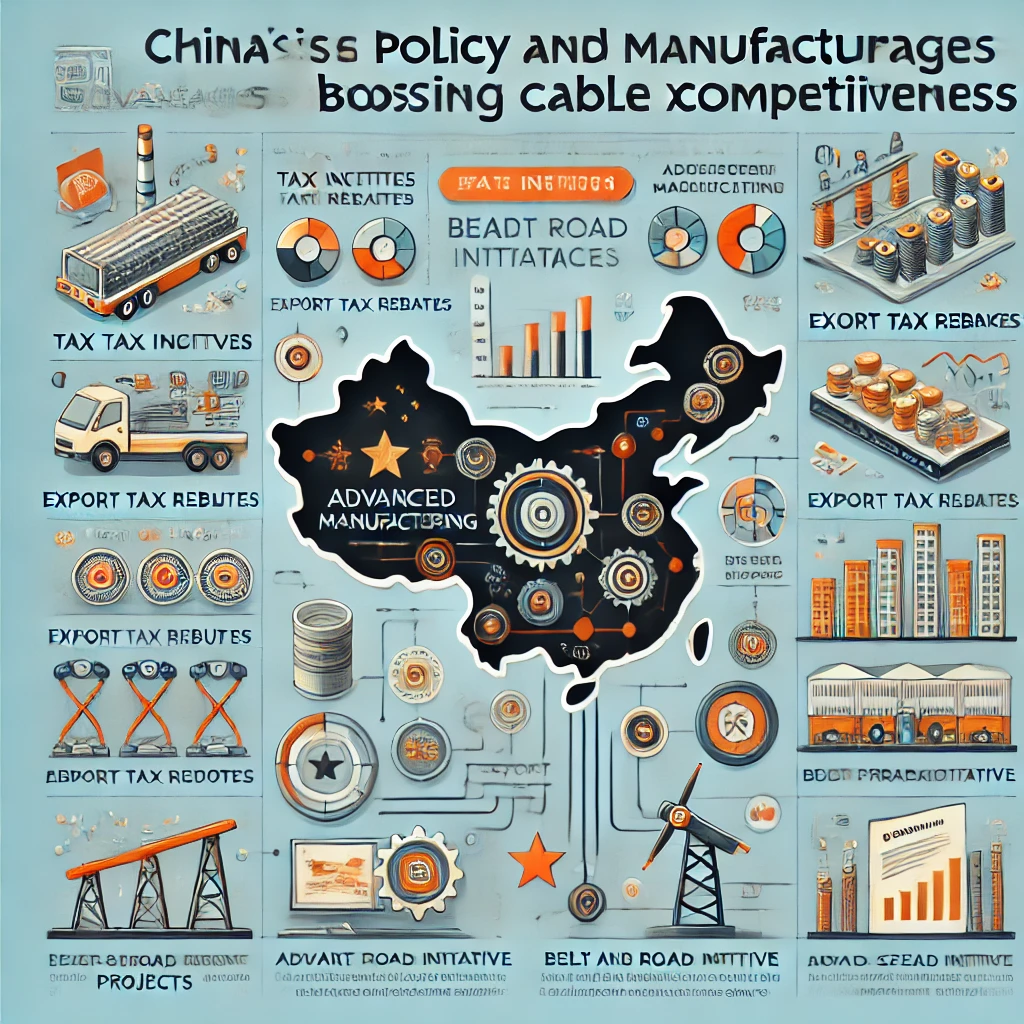
Introduction
China has emerged as a global leader in the cable manufacturing industry, thanks to favorable government policies, advanced manufacturing capabilities, and strategic advantages in production. These factors have collectively enhanced China’s competitiveness in the international market, making it a preferred source of cables for various applications. This article delves into the key policies and manufacturing advantages that underpin China’s dominance in cable exports.
Government Policies Supporting the Cable Industry
1. Tax Incentives and Subsidies
The Chinese government offers various tax incentives and subsidies to support the cable manufacturing sector. These incentives reduce the overall cost of production and enhance the global competitiveness of Chinese cable manufacturers.
- High-Tech Enterprise Status: Companies designated as high-tech enterprises benefit from a reduced corporate income tax rate of 15% compared to the standard 25%.
- Export Tax Rebates: Export-oriented companies can receive tax rebates on value-added tax (VAT) for exported goods, which can range from 13% to 17%.
2. Belt and Road Initiative (BRI)
The Belt and Road Initiative aims to enhance global trade routes and infrastructure, creating new opportunities for Chinese cable manufacturers to expand their market reach.
- Infrastructure Projects: The BRI has led to increased demand for cables in various infrastructure projects across Asia, Africa, and Europe.
- Trade Agreements: Bilateral trade agreements under the BRI framework have reduced tariffs and non-tariff barriers, facilitating smoother export processes.
3. Environmental Regulations and Compliance
China has implemented stringent environmental regulations to promote sustainable manufacturing practices. Compliance with international standards enhances the reputation of Chinese products in global markets.
- Green Manufacturing: Incentives for adopting eco-friendly technologies and processes have positioned Chinese manufacturers as leaders in sustainable production.
Manufacturing Advantages
1. Economies of Scale
China’s large-scale production capabilities enable manufacturers to achieve significant economies of scale, reducing per-unit costs and enhancing price competitiveness.
- Large Manufacturing Base: China’s cable manufacturing industry comprises numerous large-scale factories with advanced production lines.
- High Production Volumes: High output capacities allow manufacturers to meet large orders efficiently, catering to global demand.
| Indicator | China | Global Average |
|---|---|---|
| Production Capacity (tons) | 5 million | 2 million |
| Export Volume (tons) | 3 million | 1 million |
| Average Cost Reduction (%) | 20-30% | 10-15% |
2. Advanced Technology and Innovation
Continuous investment in research and development has led to significant technological advancements in cable manufacturing.
- High-Quality Products: Chinese manufacturers produce a wide range of high-quality cables, including high-voltage, fiber-optic, and environmentally friendly cables.
- Innovation Centers: Establishment of R&D centers focused on developing new materials and improving production processes.
| Technology | Description |
|---|---|
| High-Voltage Cables | Used for power transmission with minimal loss |
| Fiber-Optic Cables | Essential for high-speed data transmission |
| Environmentally Friendly Cables | Made with eco-friendly materials and processes |
3. Labor Cost Advantage
Despite rising labor costs in recent years, China still maintains a labor cost advantage compared to many developed countries.
- Skilled Workforce: A large pool of skilled labor is available at competitive wages.
- Automation and Efficiency: Adoption of automation technologies has increased production efficiency, offsetting labor cost increases.
| Region | Average Labor Cost (USD/hour) |
|---|---|
| China | 6.50 |
| United States | 25.00 |
| European Union | 30.00 |
Export Performance and Future Trends
Current Export Performance
China’s cable exports have shown consistent growth, driven by strong demand from key markets such as North America, Europe, and Southeast Asia.
- Export Value: The export value of cables from China reached $20 billion in 2022, reflecting a compound annual growth rate (CAGR) of 10% over the past five years.
- Market Share: China holds a dominant share of the global cable market, accounting for approximately 35% of global exports.
| Year | Export Value (USD billion) | Growth Rate (%) |
|---|---|---|
| 2018 | 15 | 8 |
| 2019 | 16 | 6 |
| 2020 | 17 | 6 |
| 2021 | 19 | 11 |
| 2022 | 20 | 5 |
Future Trends
The future of China’s cable exports looks promising, with several trends expected to shape the industry.
- Increasing Demand for Renewable Energy Projects:
- The global shift towards renewable energy sources such as solar and wind power is driving demand for specialized cables.
- Expansion into Emerging Markets:
- Emerging markets in Africa and Latin America present new opportunities for Chinese cable manufacturers.
- Technological Advancements:
- Continued investment in R&D will lead to the development of advanced cable technologies, further enhancing export competitiveness.
Conclusion
China’s cable manufacturing industry benefits from a combination of favorable government policies, advanced production capabilities, and strategic advantages. These factors have positioned Chinese manufacturers as leaders in the global market, driving robust export performance. Looking ahead, the industry is set to capitalize on growing demand for renewable energy, expansion into new markets, and ongoing technological advancements.
For more detailed information and data on China’s cable industry, refer to sources such as the China Chamber of Commerce for Import and Export of Machinery and Electronic Products (CCCME) and industry reports from global market research firms.
References
- China Chamber of Commerce for Import and Export of Machinery and Electronic Products (CCCME): CCCME
- London Metal Exchange (LME): LME
- International Copper Study Group (ICSG): ICSG
- World Bank Commodities Data: World Bank
